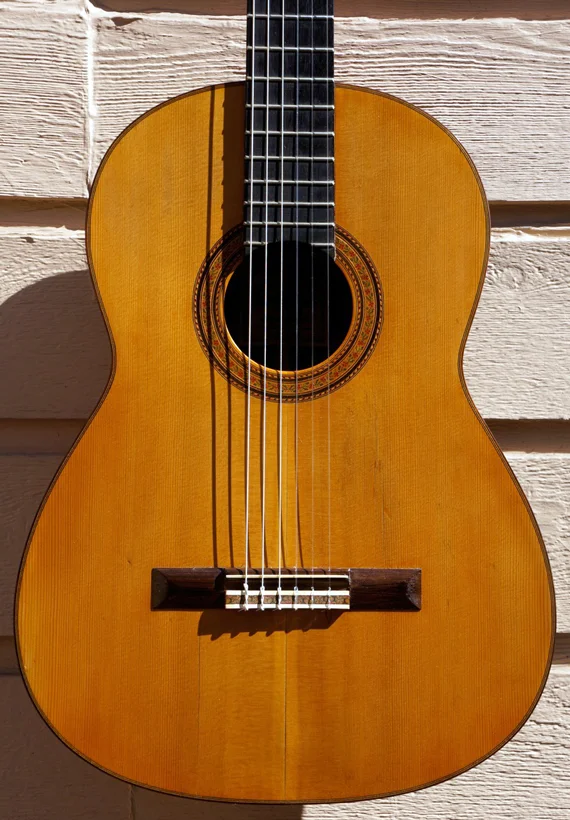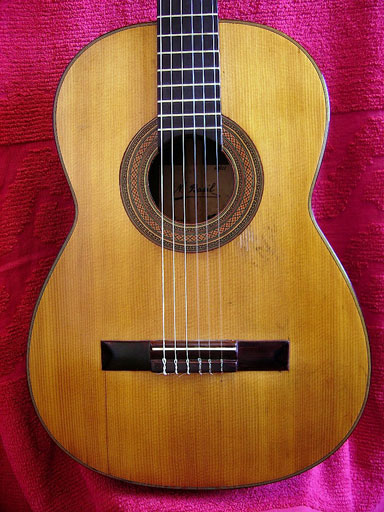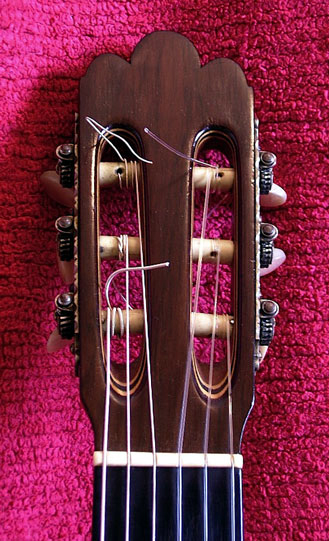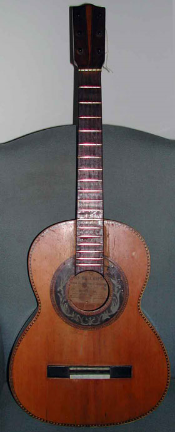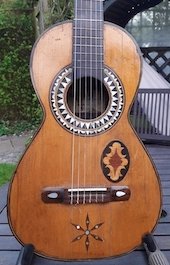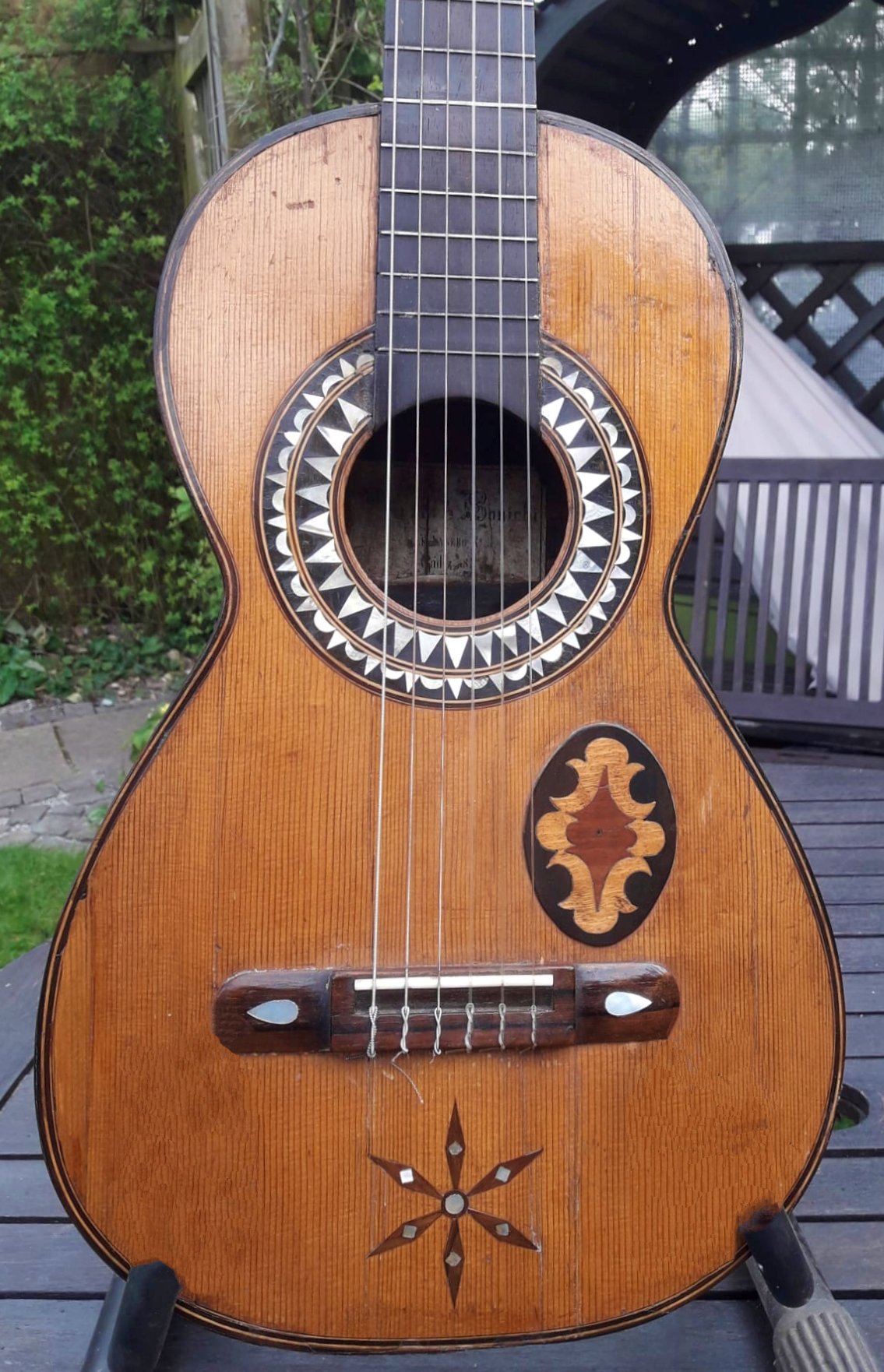Alfonso Checa (Baza, active 1935-1978)
Born in 1914, Alfonso Checa Plaza was a guitar maker from Baza, a town in the province of Granada, who opened his workshop in 1935. During his life he was a renowned maker, and had won a first prize medal for his guitars at the International Exposition in Madrid in 1953 as well as first prize later in an exposition in Ronda. He trained his sons Jose and Vicente Checa, Vicente Perez Checa, Antonio Ruiz, and Pedro Martínez Peñalver. Pedro Martinez Peñalver started with him as an apprentice in 1962, and took over his workshop after his death in 1977. As Baza is a small provincial town, Checa made guitars for other makers, notably for Gerundino Fernandez, Jose Ramirez, Luis Aróstegui, and Benito Ferrer.
Augustine Caro Riaño (Granada, active c. 1800s-1820s)
Augustine Caro Riaño was active in Granada in the first quarter of the 19th century. He was a watchmaker by profession, but built guitars in his spare time.
Photo courtesy of Spanish Guitar Shop.
Manuel de la Chica (Granada, b. 1911- 1998)
Manuel de la Chica was a Granada maker who was born in 1911. Like many guitar makers, Manuel de la Chica began as a cabinet maker. He did this work until the late 1930s, when he decided to build guitars. Already familiar with tools, woods, and having studied a little about acoustics, without any apprenticeship, he began to copy the guitars of Santos Hernandez. In time, however, he began to evolve his own designs. He felt that if you understand how sound travels, then you can improve a guitar's volume and tone. His technique wasto study how sound waves travel through the guitar. He claimed that the secret to making a great guitar was to take maximum of the vibrations that begin at the bridge and stop at the height of the sound hole. Although he achieved fame as a guitar maker, as a luthier Manuel built not only classical and flamenco guitars, butbandurrias, laúdes, bandurrins, laudins, laudons and guitar basses. Among his disciples are Antonio Lopez of Paris, Francisco Manuel Diaz of Granada, and Pedro Maldonado of Malaga. Manuel de la Chica retired in 1973 due to poor health. He died in 1998. His instruments were played by Andrés Segovia, Celedonio Romero, Luis Sanchez, Manuel Cano and Sebastian Maroto.
José Contreras(Granada active. c. 1730-1779)
José Contreras, known as "El Granadino," was born in Granada in the early 18th century. He is believed to have apprenticed in Italy, where he crafted violins in the style of Guarneri. In addition to violins, he also built guitars. Around 1740, he moved to Madrid, where he continued his work until his death in 1779.
Antonio Duran (Granada b. 1940 - d. 2007).
Antonio Durán was born in Granada in 1940. He began working at the age of ten, first in an insurance office, then in a pasta factory, and later as a woodworker. His journey into guitar making began when he joined the workshop of Eduardo Ferrer, initially crafting castanets before becoming an apprentice in the art of guitar making. He eventually married one of Eduardo Ferrer’s daughters.
In 1957, Antonio suffered a tragic accident at work, resulting in the loss of his right arm. Despite this setback, he opened his own workshop in 1958. For his classical guitars, he adopted Ferrer’s system, but his flamenco guitars are built using a completely different method. Although Antonio builds more classical guitars than flamenco guitars due to higher demand, his work is highly regarded in both styles.
Several notable guitar makers apprenticed under him, including Juan López Aguilarte, Antonio Velázquez Reinosa, and Rafael Moreno Aguilar, the latter two continuing their training under Eduardo Ferrer. Agustín Carmona and his son have also worked in Antonio Durán’s workshop. Antonio’s son, Eduardo Durán Ferrer, has followed in his footsteps and become a respected guitar maker in his own right.
Benito Ferrer(Granada, b. 1845-d. 1925)
Benito Ferrer was born in 1845 in Orihuela, Alicante. His father, originally from Granada, was a road engineer who had spent some time in the province. Tragically, Benito's father died when he was very young, prompting the family to return to Granada.
While in his third year of medical school and engaged to be married, Benito’s life took a dramatic turn when his family fell on hard times. His mother died during a cholera epidemic that swept through Granada, leaving him as the sole provider for his younger siblings. Without visible means of support or a profession, Benito was forced to leave school, break off his engagement, and find work.
He secured a position with a notary, but his wages were barely enough to sustain himself, let alone his eight siblings. To supplement his income, Benito played the bandurria, his great passion, and occasionally assisted D. José Ortega in building musical instruments. Unable to afford a better bandurria for himself, Benito decided to build one. The quality of his work attracted immediate attention, and he soon found himself overwhelmed with orders. Thus began his career as a luthier.
In 1875, Benito Ferrer established his workshop, where he trained numerous apprentices who would go on to make significant contributions to the craft, including Nicolás Ortega, José Castaño, and his nephew Eduardo Ferrer.
Although Benito is perhaps best remembered for giving a classical guitar to Andrés Segovia during the early days of his career—recognizing that the impoverished young musician had no means to buy an instrument and was practicing on borrowed guitars—his family remembers him for his kindness and selflessness.
Benito never married, instead devoting his life to raising his siblings. Even after they married, he continued to support them, often buying clothes and shoes for his nephews. Known for his good humor and occasional pranks, Benito was regarded as a saint by his family for his sacrifices. He passed away in 1925.
Photograph courtesy of Félix Manzanero.
Eduardo Ferrer Castillo (Granada, b. 1905- d. 1988)
Eduardo Ferrer was born in 1905. At around the age of ten or twelve, he began an apprenticeship in his uncle Benito Ferrer’s workshop. For a time, he also attended seminary school, contemplating a life as a priest, but eventually decided against it. When his uncle passed away in 1925, Eduardo took over the workshop.
Eduardo's life was a remarkable journey, from his early days as an apprentice earning nothing to his experiences during the Spanish Civil War when selling a guitar for twenty pesetas felt like a fortune. As a luthier, Eduardo's work closely followed the traditions of his uncle Benito Ferrer and Antonio de Torres. Although he experimented with various techniques, he ultimately returned to the proven methods of these masters. Eduardo believed they had already explored all there was to discover in guitar making, leaving little room for further innovation.
Eduardo’s significance extends beyond his craftsmanship; he was a pivotal figure in training future generations of guitar makers. Nearly all of the luthiers currently working in Granada either apprenticed with him or were taught by those who did. His apprentices included José Castaño and Milan, who continued their studies with him after Benito’s death, as well as Juan López (who died during the Spanish Civil War), Miguel Robles, Manuel Fernández, Francisco Manuel Díaz, Manuel López, Antonio Marín, his own son José Ferrer, and many others.
Eduardo also played an instrumental role in introducing classical guitar making techniques to Japan. Between 1966 and 1968, he spent three months each year in Japan training Yamaha workers in guitar construction methods, further solidifying his global influence as a luthier.
Eduardo Ferrer’s legacy as both a craftsman and teacher continues to shape the art of guitar making to this day.
José Ferrer (Granada, b. 1926-d. 1976)
José Ferrer, the son of renowned luthier Eduardo Ferrer, was born in Granada in 1926. Growing up surrounded by the art of guitar making, he began learning the craft in his father’s workshop from an early age.
During the Spanish Civil War and its aftermath, economic hardships forced José to seek other work, as few Spaniards could afford guitars, which were considered a luxury. Recognizing this, he moved to Barcelona, where he spent seven years making professional castanets. While in Barcelona, he met Enrique Sanfeliu, a disciple of the legendary luthier Enrique García. Sanfeliu encouraged José to return to guitar making, reigniting his passion for the craft.
After leaving Barcelona, José relocated to Palma de Mallorca, where he lived and worked for ten years. In 1974, he returned to Granada and set up his own workshop. Sadly, his return to his roots was short-lived; José passed away on July 1, 1976, just two years later.
Antonio Llorente (Granada, active c. 1830s)
Antonio Llorente was a luthier in Granada during the early 19th century. His workshop was located at Calle de Solarillo de Santo Domingo, 7. He trained his son, Enrique Llorente, who continued the family tradition by taking over the workshop after Antonio's death.
Enique Llorente (Granada, Active 1860s–1900s)
Enrique Llorente, the son of Antonio Llorente, was a prominent guitar maker in Granada during the latter half of the 19th century. He continued the family tradition, operating his workshop at Calle de Solarillo de Santo Domingo, 7.
S. Malgareyo (Granada, Active c. 1915)
S. Malgareyo was a guitar maker active in Granada around 1915.
Bernandino Milan Suárez (Granada active c. 1890s-1940s)
Bernardino Milán Suárez was a skilled guitar maker who worked for the Casa Ferrer in Granada. Between 1899 and 1909, he operated his own shop on Calle Elvira, where he built guitars under his own name. After this period, he appears to have joined Don Benito Ferrer’s workshop as a master craftsman. Following Don Benito’s death in 1925, Bernardino continued working at Casa Ferrer under Eduardo Ferrer for many years.
Later in life, Bernardino established his own workshop once again, but he passed away just two or three years later, leaving no family.
Photo: Bernardino Milán Suárez guitar courtesy of Spanish Guitar Shop.
Manuel Martinez de Milan (b. Canales, 1923-d. Granada 1957)
Manuel Martínez de Milán was born in 1923 in Canales. During his childhood, he worked as a shepherd in his hometown. Upon moving to Granada, he apprenticed as a cabinet maker at Casa Ramos. He later moved to Tíjola, where he began crafting musical instruments.
From Tíjola, Manuel relocated to Madrid, where he worked in a furniture factory. Eventually, he and his friend Miguel Robles established a workshop in El Rastro.
Around 1957, Manuel abruptly abandoned his family and moved to France, where he passed away in his forties. Following his death, Francisco Fernández, who appears to have trained under him, took over his workshop.
José Ortega (Granada, Active 1860s–1900s)
José Ortega was a prominent guitar maker in Granada during the latter half of the 19th century. His workshop was located at Mesones, 4. He is believed to have been the teacher of Benito Ferrer.
Nicolás Ortega Ruiz (Granada, 1861–?)
Nicolás Ortega Ruiz, the son of José Ortega, was born in Granada in 1861. He worked alongside his father and brother before later collaborating with Benito Ferrer.
José Pernas (Granada, Active c. 1830s–1870s)
José Pernas was a Granada-based guitar maker who is reputed to have trained Antonio de Torres. However, some doubt exists regarding this claim, as there is no documented evidence showing that Torres was in Granada during the period he was supposedly studying under Pernas.
Miguel Robles (Granada, 1902–1970)
Miguel Robles was born in Granada in 1902. At the age of 14 or 15, he began working with wood in Abelardo Linares’s shop. By the time he was 18 or 20, he apprenticed with Benito Ferrer.
In 1932, Miguel moved to Madrid, where he worked for José Ramírez II for six or seven years before a falling out ended their collaboration. He also worked for Santos Hernández for a time before returning to Granada, where he established a shop on Calle de la Colcha.
After the Spanish Civil War, José Ramírez, recognizing the cost of Miguel's departure, traveled to Granada to ask him to return to Madrid. Miguel eventually did so, but in the mid-1950s, he moved back to Madrid and established a workshop in El Rastro with his friend Manuel Martínez de Milán.
After several years, Miguel returned to Granada and opened a workshop on Calle Elvira, where he continued his work until his death in 1970. He primarily built flamenco guitars, which were played by notable musicians such as Manuel Cano, Manuel Martín Liñán, and the Mexican trio Los Panchos.
Miguel trained several prominent luthiers, including Manuel Martínez de Milán, Francisco Guardia, and Pedro Maldonado.
Nicolás and Antonio del Valle (Granada, Active 1840s–1860s)
Nicolás and Antonio del Valle, brothers, were guitar makers in Granada during the mid-19th century. Their workshop was located at Calle Elvira, 54.
Rafael Vallejo (Baza, Active c. 1790)
Rafael Vallejo was a guitar maker from Baza, a town in the province of Granada. In 1792, he received a royal commission to build a guitar for King Carlos IV of Spain. This guitar is now preserved in the Victoria and Albert Museum in London.



